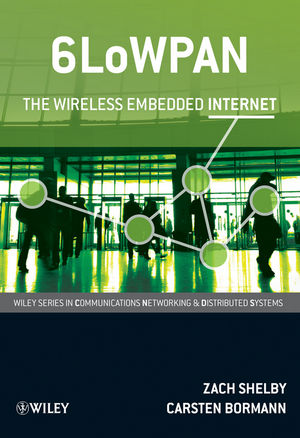6LoWPAN: The Wireless Embedded InternetISBN: 978-0-470-74799-5
Hardcover
244 pages
December 2009
 This is a Print-on-Demand title. It will be printed specifically to fill your order. Please allow an additional 15-20 days delivery time. The book is not returnable.
|
||||||
List of Figures ix
List of Tables xiii
Foreword xv
Preface xvii
Acknowledgments xix
1 Introduction 1
1.1 The Wireless Embedded Internet 3
1.1.1 Why 6LoWPAN? 4
1.1.2 6LoWPAN history and standardization 6
1.1.3 Relation of 6LoWPAN toother trends 8
1.1.4 Applications of 6LoWPAN 9
1.1.5 Example: facility management 11
1.2 The 6LoWPAN Architecture 13
1.3 6LoWPAN Introduction 15
1.3.1 The protocol stack 16
1.3.2 Link layers for 6LoWPAN 17
1.3.3 Addressing 19
1.3.4 Header format 20
1.3.5 Bootstrapping 20
1.3.6 Mesh topologies 22
1.3.7 Internet integration 23
1.4 Network Example 24
2 The 6LoWPAN Format 27
2.1 Functions of an Adaptation Layer 28
2.2 Assumptions About the Link Layer 29
2.2.1 Link-layer technologies beyond IEEE 802.15.4 29
2.2.2 Link-layer service model 30
2.2.3 Link-layer addressing 31
2.2.4 Link-layer management and operation 32
2.3 The Basic 6LoWPAN Format 32
2.4 Addressing 34
2.5 Forwarding and Routing 37
2.5.1 L2 forwarding (“Mesh-Under”) 38
2.5.2 L3 routing (“Route-Over”) 40
2.6 Header Compression 41
2.6.1 Stateless header compression 43
2.6.2 Context-based header compression 45
2.7 Fragmentation and Reassembly 52
2.7.1 The fragmentation format 55
2.7.2 Avoiding the fragmentation performance penalty 59
2.8 Multicast 59
3 Bootstrapping and Security 63
3.1 Commissioning 64
3.2 Neighbor Discovery 66
3.2.1 Forming addresses 67
3.2.2 Registration 69
3.2.3 Registration collisions 73
3.2.4 Multihop registration 77
3.2.5 Node operation 80
3.2.6 Router operation 81
3.2.7 Edge router operation 82
3.3 Security 83
3.3.1 Security objectives and threat models 84
3.3.2 Layer2 mechanisms 85
3.3.3 Layer3 mechanisms 87
3.3.4 Key management 89
4 Mobility and Routing 91
4.1 Mobility 92
4.1.1 Mobility types 92
4.1.2 Solutions for mobility 94
4.1.3 Application methods 96
4.1.4 Mobile IPv6 97
4.1.5 Proxy Home Agent 100
4.1.6 ProxyMIPv6 100
4.1.7 NEMO 102
4.2 Routing 104
4.2.1 Overview 104
4.2.2 The role of Neighbor Discovery 107
4.2.3 Routing requirements 108
4.2.4 Route metrics 109
4.2.5 MANET routing protocols 111
4.2.6 The ROLL routing protocol 114
4.2.7 Border routing 119
4.3 IPv4 Interconnectivity 120
4.3.1 IPv6 transition 121
4.3.2 IPv6-in-IPv4 tunneling 122
5 Application Protocols 125
5.1 Introduction 126
5.2 Design Issues 127
5.2.1 Linklayer 129
5.2.2 Networking 130
5.2.3 Host issues 130
5.2.4 Compression 131
5.2.5 Security 131
5.3 Protocol Paradigms 132
5.3.1 End-to-end 132
5.3.2 Real-time streaming and sessions 132
5.3.3 Publish/subscribe 133
5.3.4 Web service paradigms 134
5.4 Common Protocols 134
5.4.1 Web service protocols 135
5.4.2 MQ telemetry transport for sensor networks (MQTT-S) 137
5.4.3 ZigBee compact application protocol (CAP) 139
5.4.4 Service discovery 141
5.4.5 Simple network management protocol (SNMP) 142
5.4.6 Real-time transport and sessions 143
5.4.7 Industry-specific protocols 144
6 Using 6LoWPAN 149
6.1 Chip Solutions 150
6.1.1 Single-chip solutions 150
6.1.2 Two-chip solutions 151
6.1.3 Network processor solutions 151
6.2 Protocol Stacks 152
6.2.1 ContikianduIPv6 153
6.2.2 TinyOS and BLIP 153
6.2.3 Sensinode NanoStack 154
6.2.4 Jennic6LoWPAN 155
6.2.5 Nivis ISA100 155
6.3 Application Development 156
6.4 Edge Router Integration 159
7 System Examples 163
7.1 ISA100 Industrial Automation 164
7.1.1 Motivation for industrial wireless sensor networks 164
7.1.2 Complications of the industrial space 165
7.1.3 The ISA100.11a standard 166
7.1.4 ISA100.11a data link layer 169
7.2 Wireless RFID Infrastructure 170
7.2.1 Technical overview 172
7.2.2 Benefits from 6LoWPAN 173
7.3 Building Energy Savings and Management 174
7.3.1 Network architecture 174
7.3.2 Technical overview 174
7.3.3 Benefits from 6LoWPAN 175
8 Conclusion 177
A IPv6 Reference 181
A.1 Notation 181
A.2 Addressing 182
A.3 IPv6 Neighbor Discovery 184
A.4 IPv6 Stateless Address Autoconfiguration 188
B IEEE 802.15.4 Reference 191
B.1 Introduction 191
B.2 Overall Packet Format 192
B.3 MAC-layer Security 194
List of Abbreviations 195
Glossary 203
References 209
Index 219



